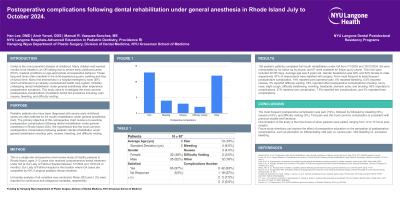Sedation
Postoperative complications following dental rehabilitation under general anesthesia in Rhode Island
148 - Postoperative complications following dental rehabilitation under general anesthesia in Rhode Island July to October 2024


Han Lee, DMD
Pediatric Dental Resident
NYU Langone Dental Medicine
NYU Langone Hospitals
North Providence, Rhode Island, United States
Amir Yavari, DDS
Associate Director
NYU Langone Dental Medicine, Brooklyn, NY
NYU Lutheran - Providence
North Providence, Rhode Island, United States- DK
Daniel J. Kane, DMD
Program Director
NYU Langone Health
Brooklyn, New York, United States
Presenting Author(s)
Research Mentor(s)
Program Director(s)
Title: Postoperative complications following dental rehabilitation under general anesthesia in Rhode Island July to October 2024
Author(s): Han Lee, DMD | Amir Yavari, DDS | Manuel R. Vazquez-Sanchez, MS
Affiliation: NYU Langone Rhode Island Pediatric Residency
Purpose: the aim of this retrospective chart review is to examine postoperative complications following dental rehabilitation under general anesthesia in Rhode Island.
Methods: This is a single-site retrospective chart review study of healthy pediatric patients ages 3-12 years who received comprehensive dental treatment under GA at Our Lady of Fatima Hospital between 7/1/2024 and 10/31/2024. Our Lady of Fatima Hospital is the location where GA cases are completed by r NYU Langone pediatric dental residdents. Univariate analysis of all variables was conducted. Mean (SD) and n (%) were
reported for continuous and categorical variables, respectively.
Results: 126 pediatric patients completed full mouth rehabilitation under GA from 7/1/2024 and 10/31/2024, 59 were
unreachable by for follow-up by phone, and 67 were available for follow-up by phone. This time span
included 40 OR days. Average age was 6 years old. Gender breakdown was 48% and 52% female to male
respectively. 97% of respondents were satisfied with surgery. From most frequent to least frequent
postoperative complication, 19% reported post operative pain, 6% reported bleeding, 4.5% reported
nausea, 3% reported difficulty voiding. 18% reported other postoperative complications including: runny
nose, slight cough, difficulty swallowing, vomiting, headache, stomach ache, and bruising. 63% reported no
complications, 27% reported one complication, 7.5% reported two complications, and 3% reported three
complications.
Conclusion: The most frequent postoperative complication was pain (19%), followed by followed by bleeding (6%), nausea (4.5%), and difficulty voiding (3%)
Identify Supporting Agency and Grant Number: n/a

.jpg)